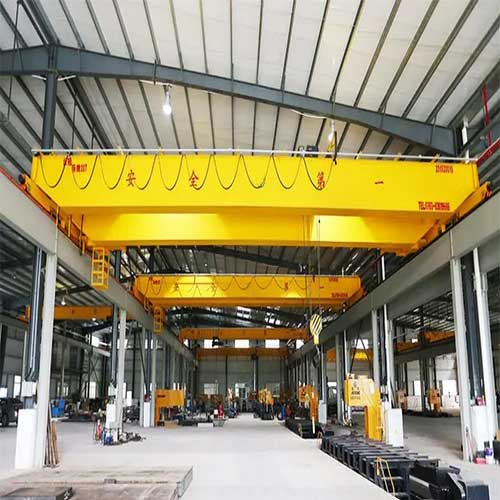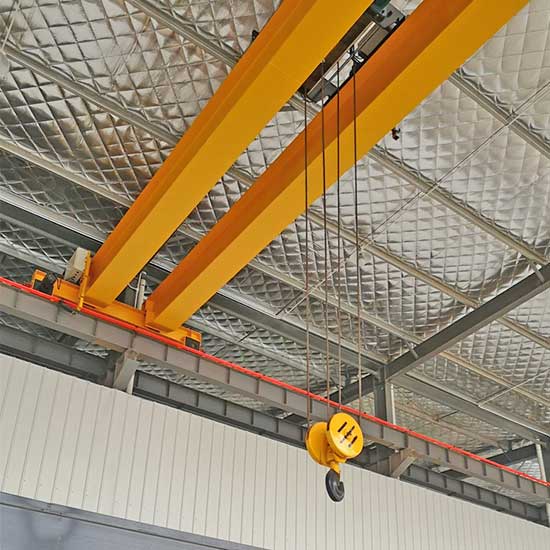3 Ton to 50 Ton Double Girder Crane Guide on Types, Benefits & Uses
Double girder cranes complete guide for you to select right types of double girder cranes for your applications. Double girder cranes for sale at good price.
Category: Overhead Crane for Your Use
Your Trusted Double Girder Crane Manufacturer & Supplier
3 Ton to 50 Ton Double Girder Crane Guide on Types, Benefits & Uses
Double Girder Cranes Guide for You to Select Right Type for Your Application
Double girder cranes complete guide for you to select right types of double girder cranes for your applications. Double girder cranes for sale at good price.
Mastering Efficiency & Safety: The Complete Guide to Double Girder Cranes
Double girder cranes are workhorses in the realm of heavy lifting and material handling. Understanding the fundamentals is key to leveraging their efficiency and ensuring safety in various industrial settings.
At its core, a double girder crane is designed with two horizontal girders spanning across the crane's width. These girders provide structural support for the trolley and hoist unit, enabling enhanced load-bearing capacity compared to single girder counterparts.
The robustness of double girder cranes lies in their structural integrity. Constructed with either box girders, I-beam girders, or truss girders, these cranes offer varying levels of strength and versatility. The choice of girder design often depends on the specific application requirements, such as load capacity and span.
What sets double girder cranes apart is their ability to handle heavier loads with greater stability and precision. The dual girder setup distributes the load evenly, reducing stress on the crane components and ensuring smoother lifting operations. Additionally, their adaptability to various below-hook devices further enhances their utility across industries.
Double girder cranes are the backbone of numerous industrial operations, serving in heavy manufacturing, construction sites, warehouses, and more. Stay tuned for our exploration into the different types of double girder cranes and their specialized applications in the next section.
Types of Double Girder Cranes
Double girder cranes come in different configurations, each tailored to specific needs and applications.Double girder cranes can be classified based on various factors such as crane design, structures, mounting types, applications, control systems, below-hook devices, operational sectors, and specialized variations. Here's an overview:
Double Girder Crane Types Based on Crane Designs
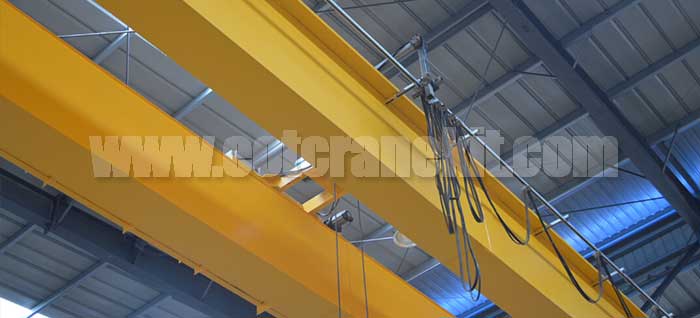
Features:
Box girder cranes are characterized by their box-shaped girders, which offer exceptional strength and torsional rigidity. This design ensures stability even in demanding lifting scenarios.
Benefits:
Superior strength-to-weight ratio compared to other designs.
Reduced deflection during heavy lifting operations.
Enhanced durability and resistance to structural deformation.
Typical Applications:
Heavy manufacturing requiring precise and stable lifting.
Environments demanding high torsional rigidity and strength, such as steel mills and foundries.
Industries with strict precision requirements like aerospace manufacturing.
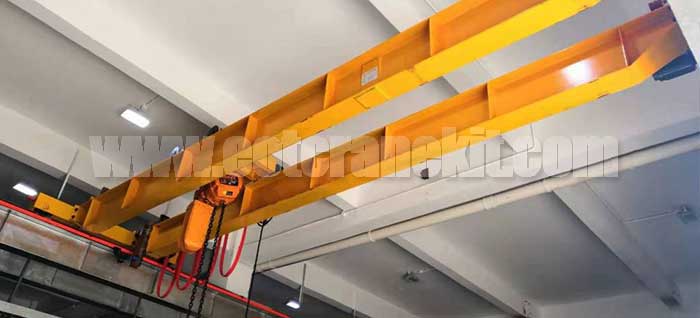
Features:
I-beam girder cranes utilize I-shaped girders, providing versatility and moderate strength suitable for various lifting tasks.
Benefits:
Versatile and adaptable to different load capacities and spans.
Cost-effective solution for moderate lifting requirements.
Ease of maintenance and accessibility for inspections.
Typical Applications:
Warehousing and logistics operations for handling moderate loads.
Construction sites where versatility in lifting is necessary.
Workshops and assembly lines in manufacturing facilities.

Truss Girder Cranes
Features:
Truss girder cranes employ a truss-style design, offering high strength while minimizing weight, making them ideal for longer spans.
Benefits:
Excellent strength-to-weight ratio, enabling longer spans without compromising load-bearing capacity.
Reduced deadweight, resulting in more efficient operations.
Suitable for handling loads over extended distances.
Typical Applications:
Large-scale construction projects requiring extended reaches.
Applications in shipyards for handling heavy components with extended spans.
Ports and material handling facilities where longer spans are essential.
Double Girder Crane Types Based on Crane Mounting Types:
Double girder cranes can be categorized based on how they are mounted or supported, with two main types: top-running and underhung double girder cranes. Each type offers unique features and benefits suitable for specific industrial applications.

Top-Running Double Girder Cranes
Overview:
Top-running double girder cranes are supported from the building's steel structure, typically via runway beams, allowing the crane to move along the top of the structure.
Typical Double Girder Crane Design & Capacities:
Designed with sturdy double girders for enhanced load-bearing capacities.
Capacities range from 5 tons to over 100 tons, depending on the specific design and requirements.
Typical Crane Features and Benefits:
High Stability: Offers excellent stability due to support from the building structure.
Greater Heights and Spans: Suitable for applications requiring higher lifting heights and longer spans.
Versatility: Adaptable for various below-hook devices and configurations.
Applicable Industries of Top-Running Double Girder Cranes:
Heavy Manufacturing: Ideal for lifting heavy machinery and components in steel mills, foundries, and manufacturing plants.
Warehousing and Logistics: Efficiently handles heavy loads in warehouses and distribution centers.
Construction Sites: Assists in lifting materials and equipment in large construction projects.

Underhung Double Girder Cranes
Overview:
Underhung double girder cranes are suspended from the roof structure of the building, maximizing floor space as they do not require additional floor-mounted support structures.
Typical Double Girder Crane Design & Capacities:
Utilizes double girders for increased load capacities while being suspended from the ceiling.
Capacities range similarly from 5 tons to over 10 tons, depending on the design and requirements.
Typical Crane Features and Benefits:
Space Optimization: Maximizes floor space in industrial settings, ideal for crowded or compact areas.
Smooth Travel: Provides smooth and precise horizontal movements along the ceiling-mounted runways.
Ease of Installation: Easier to install compared to top-running cranes as they don't require floor supports.
Applicable Industries of Underhung Double Girder Cranes:
Manufacturing Facilities: Efficiently handles materials in crowded manufacturing areas.
Assembly Lines: Provides precise and controlled lifting in production and assembly lines.
Workshops: Suitable for maintenance workshops or areas with limited floor space.
These two mounting types—top-running and underhung double girder cranes—offer distinct advantages suited for various industrial applications, providing flexibility, efficiency, and optimal space utilization based on specific operational requirements.
Double Girder Crane Types Based on Runway Mounting Types
Double girder cranes vary based on how their runways are mounted or supported. There are several types, each offering specific advantages and suitability for different operational environments.
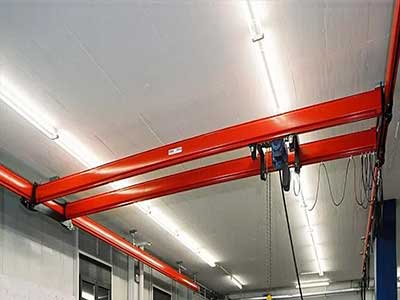
Ceiling Mounted Double Girder Cranes
Overview:
Ceiling-mounted double girder cranes are installed onto the ceiling of a facility, utilizing a structure specifically designed to support the crane's runways and movements.
Typical Double Girder Crane Design & Capacities:
Utilizes double girders for increased load capacities while being suspended from the ceiling.
Capacities range widely based on design and requirements, spanning from 5 tons to over 100 tons.
Typical Crane Features and Benefits:
Space Efficiency: Maximizes floor space, allowing unobstructed movement within the facility.
Precise Movements: Provides smooth and controlled lifting and movement operations.
Clear Floor Area: Ideal for environments requiring unobstructed ground clearance.
Applicable Industries of Ceiling Mounted Double Girder Cranes:
Manufacturing Facilities: Especially suitable for large-scale manufacturing and production setups.
Assembly Lines: Ensures precise lifting and movement in assembly processes.
Workshops: Offers efficient lifting solutions in maintenance and repair workshops.

Wall Mounted Runway Double Girder Cranes
Overview:
Wall-mounted runway double girder cranes are installed on walls or structures alongside the operational area, utilizing the facility's existing walls for support.
Typical Double Girder Crane Design & Capacities:
Utilizes double girders and mounted on walls for lifting capacities ranging from 5 tons to over 100 tons.
Typical Crane Features and Benefits:
Maximized Floor Space: Provides an open floor for operational activities and material handling.
Accessible Maintenance: Offers easier access for maintenance and inspections.
Specific Work Areas: Ideal for targeted lifting operations in designated areas.
Applicable Industries of Wall Mounted Runway Double Girder Cranes:
Warehousing and Logistics: Efficiently handles materials in warehouse settings.
Specific Manufacturing Zones: Provides targeted lifting in dedicated production zones.
Restricted Space Environments: Suited for areas with limited floor space.
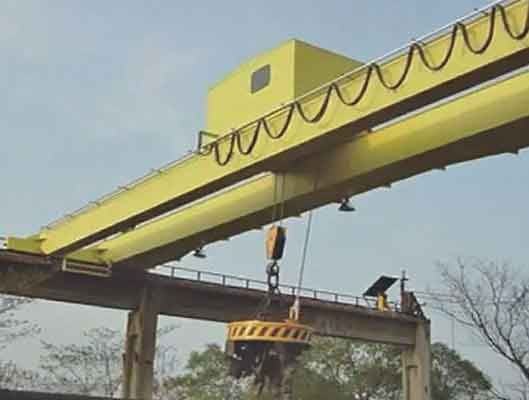
Freestanding Bridge Double Girder Cranes
Freestanding bridge double girder cranes are standalone structures with runways supported by columns or independent frameworks.
Typical Double Girder Crane Design & Capacities:
Independent structure with double girders, offering lifting capacities ranging from 5 tons to over 100 tons.
Typical Crane Features and Benefits:
Flexibility in Placement: Can be positioned based on specific operational needs.
Versatile Usage: Suitable for various industries requiring adaptable lifting solutions.
Minimal Footprint: Offers lifting capabilities without requiring support from building structures.
Applicable Industries of Freestanding Bridge Double Girder Cranes:
Outdoor Operations: Ideal for outdoor construction sites or open-air industrial facilities.
Temporary Work Areas: Suited for setups where permanent installations are not feasible.
Specific Project Requirements: Used for targeted lifting needs in temporary project sites.

Freestanding Gantry Double Girder Crane
Overview:
Freestanding gantry double girder cranes are supported by uprights or gantry legs, offering flexibility in their placement and usage.
Typical Double Girder Crane Design & Capacities:
Supported by gantry legs with double girders, providing lifting capacities ranging similarly from 5 tons to over 100 tons.
Typical Crane Features and Benefits:
Portability and Mobility: Can be moved to different locations within a facility.
Independent Support: Doesn't rely on building structures for support.
Versatile Applications: Suited for various industrial settings and operations.
Applicable Industries of Freestanding Gantry Double Girder Cranes:
Construction Sites: Offers portable lifting solutions in temporary construction setups.
Material Handling Yards: Provides flexible lifting capabilities in outdoor material yards.
Loading Docks: Efficiently handles cargo in loading and unloading areas.
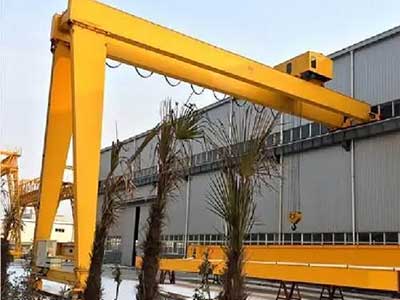
Double Girder Semi Gantry Cranes
Overview:
Half wall-mounted and half floor-mounted double girder cranes are hybrid designs, utilizing both wall and floor support structures for installation.
Typical Double Girder Crane Design & Capacities:
Utilizes a combination of wall and floor mounting to support double girders for lifting capacities ranging from 5 tons to over 100 tons.
Typical Crane Features and Benefits:
Optimized Space Utilization: Maximizes both wall and floor space for operations.
Versatile Positioning: Provides flexibility in installation based on available structural support.
Dual Support System: Offers stable lifting with combined wall and floor support.
Applicable Industries of Half Wall Mounted & Half Floor Mounted Double Girder Cranes:
Manufacturing Facilities: Offers tailored lifting solutions in areas with mixed support structures.
Large Workshops: Suitable for workshops with varying structural layouts.
Customized Environments: Adaptable to specific building configurations and spaces.
Double Girder Crane Types Based on Crane Control:
Double girder cranes offer different control systems that cater to varying operational needs, including manual control systems, remote control systems, and automated control systems, each providing distinct advantages in controlling crane movements and operations.

Manual Control Systems
Overview:
Double girder cranes with manual control systems are operated using hand controls, requiring direct physical input from the operator for crane movements.
Typical Control System Features and Benefits:
Hands-on Operation: Control by the operator using control pendants or buttons.
Operator Precision: Allows operators to have direct control over lifting and movement.
Reliability: Simplicity in operation and reliability in basic lifting operations.
Applicable Industries of Manual Control Systems Double Girder Cranes:
Small-scale Manufacturing
Workshop Environments
Basic Material Handling Operations

Remote Control Systems
Overview:
Double girder cranes equipped with remote control systems operate using wireless remote devices, allowing operators to control the crane from a distance.
Typical Control System Features and Benefits:
Wireless Operation: Allows operators to control the crane from a safe distance.
Enhanced Safety: Enables operators to maintain a safe distance from the load or hazardous areas.
Improved Accessibility: Facilitates better visibility during crane operations.
Applicable Industries of Remote Control Systems Double Girder Cranes:
Hazardous Environments
Operations Requiring Constant Mobility
Areas with Limited Accessibility

Overview:
Double girder cranes integrated with automated control systems utilize advanced automation for precise and efficient crane movements.
Typical Control System Features and Benefits:
Precision and Accuracy: Automated systems ensure precise positioning and lifting.
Enhanced Efficiency: Streamlines crane operations, reducing human intervention.
Sophisticated Programming: Allows for complex movement patterns and sequences.
Applicable Industries of Automated Control Systems Double Girder Cranes:
High-Volume Manufacturing
Industries Requiring High Precision and Repetitive Movements
Processes Demanding Complex and Customized Lifting Operations
Each type of control system for double girder cranes offers unique advantages catering to different operational scenarios and industry requirements. The choice between manual, remote, or automated control systems depends on the specific operational needs, safety considerations, and the level of precision and automation desired within industrial applications. Selecting the appropriate control system enhances operational efficiency, safety standards, and productivity within various industrial environments.
Double Girder Crane Types Based on Crane Below-Hook Devices:
Double girder cranes are equipped with diverse below-hook devices that enhance their versatility in handling various loads. The types include hooks, magnets, and grabs, each tailored for specific material handling requirements.
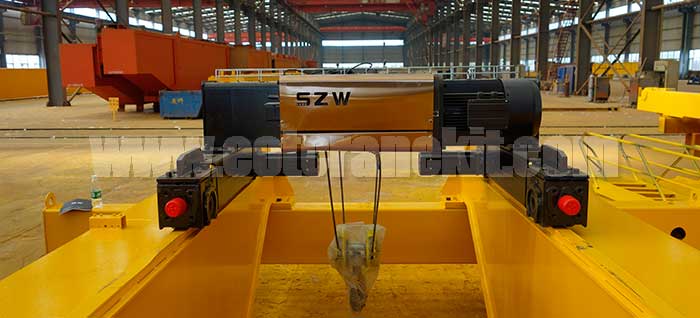
Hooks
Overview:
Hooks are standard lifting attachments widely used for various loads and are one of the most common below-hook devices for double girder cranes.
Typical Below-Hook Device Features and Benefits:
Versatile Lifting: Suitable for a wide range of loads and materials.
Secure Attachment: Offers a reliable grip for lifting different types of loads.
Ease of Use: Simple and widely applicable for general lifting operations.
Applicable Industries for Hook-based Double Girder Cranes:
General Manufacturing
Warehousing and Logistics
Construction Sites
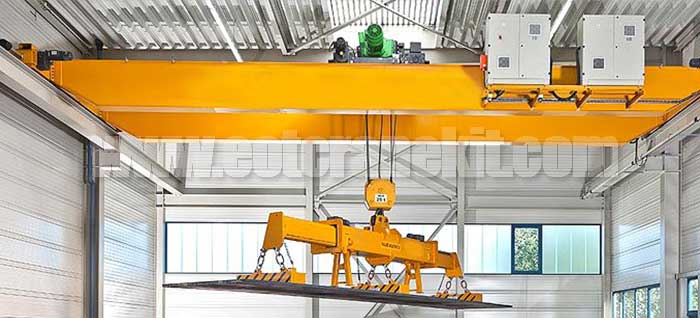
Magnets
Overview:
Magnets serve the purpose of lifting ferrous materials efficiently without the need for slings or hooks, enhancing material handling capabilities.
Typical Below-Hook Device Features and Benefits:
Specific Material Handling: Designed for lifting ferrous materials like steel plates and components.
Enhanced Safety: Ensures secure lifting without the use of additional hooks or slings.
Efficient Operations: Speeds up material handling processes for ferrous loads.
Applicable Industries for Magnet-based Double Girder Cranes:
Steel Mills
Metal Fabrication Facilities
Scrap Metal Yards
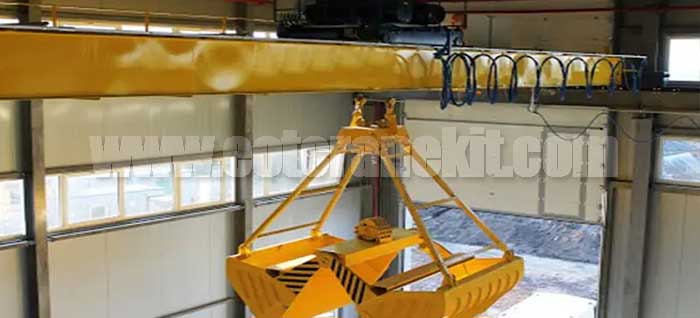
Grabs
Overview:
Grabs are below-hook devices specialized for handling loose bulk materials, allowing the crane to grab and hold materials during lifting.
Typical Below-Hook Device Features and Benefits:
Bulk Material Handling: Suited for lifting loose materials like sand, gravel, or bulk commodities.
Optimized Loading: Facilitates efficient loading and unloading of loose materials.
Minimized Spillage: Ensures secure handling of bulk materials, reducing spillage risks.
Applicable Industries for Grab-based Double Girder Cranes:
Mining Operations
Ports and Material Handling Yards
Construction Sites with Bulk Material Requirements
The selection of below-hook devices for double girder cranes depends on the specific material handling needs within different industries. By choosing the appropriate below-hook device, double girder cranes can efficiently handle various types of loads, ensuring secure and optimized material handling operations. Each type of below-hook device offers unique benefits, catering to specific material handling requirements and industries.
Specialized Double Girder Cranes
These specialized double girder cranes cater to unique operational requirements, providing tailored solutions for specific industries or tasks that demand specialized features, capacities, or functionalities. Their design and features are customized to meet the challenging demands of various industrial applications, ensuring safety, efficiency, and reliability in specific working environments.

Overview:
Casting cranes are specifically designed to handle molten metal or heavy castings in foundries and metalworking industries, boasting construction that withstands high-temperature environments.
Key Features and Benefits of Casting Cranes:
Heat Resistance: Constructed to endure extreme temperatures prevalent in foundries.
Robust Build: Capable of safely handling heavy and molten materials.
Precision Handling: Enables controlled movements when dealing with delicate castings.
Applicable Industries:
Foundries
Metalworking Facilities
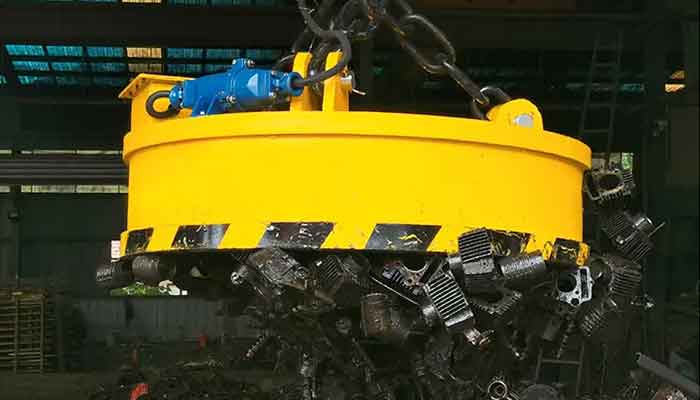
Overview:
Scrap handling cranes are optimized for efficiently lifting and transporting scrap metal, primarily used in recycling yards, scrap processing facilities, and metalworking industries.
Key Features and Benefits of Scrap Handling Cranes:
Efficient Material Handling: Designed for precise movement and transportation of scrap metal.
Durable Construction: Built to endure abrasive materials found in scrap metal.
Enhanced Productivity: Streamlines operations in scrap recycling and processing.
Applicable Industries:
Recycling Yards
Scrap Processing Facilities
Metalworking Industries

Maintenance Cranes with variable speed control
Overview:
Maintenance cranes are specialized equipment designed for conducting various maintenance tasks in industrial settings. They provide crucial assistance in machinery repairs, equipment servicing, and maintenance operations across diverse industries.
Typical Double Girder Crane Design & Capacities:
Robust Construction: Incorporates double girders for enhanced stability and load-bearing capabilities.
Capacities: Range typically from 5 tons to over 100 tons, offering flexibility for various maintenance requirements and lifting needs.
Typical Crane Features and Benefits:
Customizable Configurations: Tailored setups to suit specific maintenance operations and lifting demands.
Precise Movements: Ensures accurate positioning of machinery during maintenance tasks.
Specialized Attachments: Different variants like foundry cranes, explosion-proof cranes, and magnetic cranes for specific maintenance requirements.
Safety Measures: Equipped with safety features to ensure secure operations, even in hazardous environments.
Applicable Industries of Maintenance Cranes:
Industrial Facilities: Essential for maintenance operations within manufacturing plants, warehouses, and workshops.
Hazardous Environments: Explosion-proof cranes provide safety during maintenance in areas with explosive materials.
Specialized Material Handling Needs: Magnetic cranes cater to handling magnetic materials during maintenance tasks.

Overview:
Foundry cranes are specifically designed to operate in high-temperature foundry environments, providing essential lifting and handling capabilities for materials within these settings.
Typical Double Girder Crane Design & Capacities:
Heat-resistant Build: Constructed to withstand extreme temperatures prevalent in foundries.
Load Capacities: Ranging typically from 5 tons to over 100 tons, depending on foundry requirements.
Typical Crane Features and Benefits:
Heat Resistance: Ability to function safely and efficiently in high-temperature environments.
Robustness: Durable construction for lifting and moving heavy materials.
Precision Handling: Ensures controlled movements in handling delicate materials.
Applicable Industries of Foundry Cranes:
Foundries: Crucial equipment for handling molten metal and heavy castings in foundry operations.
Metalworking Facilities: Supports material handling needs in high-temperature environments.

Overview:
Explosion-proof cranes are designed to operate safely in hazardous environments where explosive materials or gases might be present.
Typical Double Girder Crane Design & Capacities:
Intrinsically Safe Design: Engineered to prevent sparks or ignition sources in potentially explosive atmospheres.
Capacities: Similar to other maintenance cranes, ranging from 5 tons to over 100 tons, based on requirements.
Typical Crane Features and Benefits:
Safety Assurance: Ensures safe operations in hazardous environments.
Risk Mitigation: Reduces the potential for ignition sources in explosive atmospheres.
Functional Versatility: Performs maintenance tasks without compromising safety in such environments.
Applicable Industries of Explosion-proof Cranes:
Chemical Plants
Oil and Gas Refineries
Any Environment with Explosive Materials
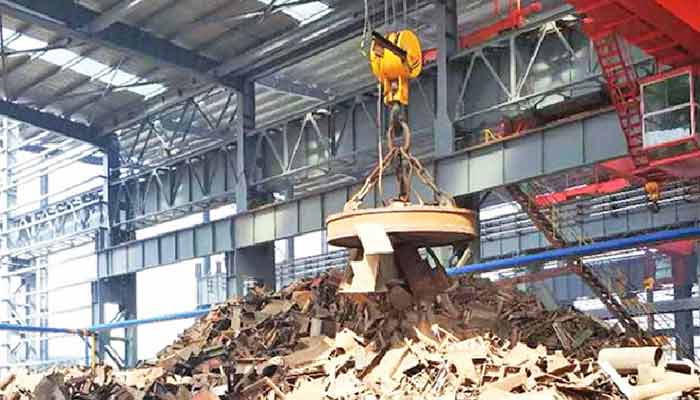
Overview:
Magnetic cranes are equipped with magnets specifically for lifting and moving magnetic materials, catering to industries with specific material handling needs.
Typical Double Girder Crane Design & Capacities:
Magnetic Systems: Integrates powerful magnet systems for efficient lifting and movement of magnetic loads.
Capacities: Similar to other maintenance cranes, ranging from 5 tons to over 100 tons.
Typical Crane Features and Benefits:
Efficient Material Handling: Facilitates the handling of magnetic materials with ease.
Reduced Manual Handling: Eliminates the need for manual intervention in material handling.
Enhanced Productivity: Streamlines material movement operations.
Applicable Industries of Magnetic Cranes:
Steel Mills
Metal Recycling Facilities
Any Industry Handling Magnetic Materials
Typical Industrial Applications of Double Girder Cranes
Double girder cranes find extensive utility across diverse industrial sectors due to their robustness and lifting capabilities.
Double girder cranes are tailored to meet specific industrial applications, offering targeted lifting solutions for various sectors, including heavy manufacturing, warehousing, construction, automotive, shipbuilding, and ports.
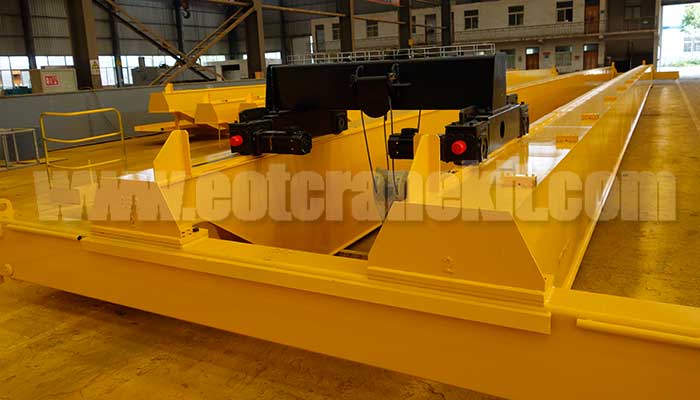
Overview:
Double girder cranes designed for heavy manufacturing excel in handling heavy machinery and equipment within industrial facilities.
Typical Double Girder Crane Design & Capacities:
Robust design with double girders to manage substantial weights and loads.
Capacities range from 5 tons to over 100 tons, accommodating heavy machinery lifting.
Typical Crane Features and Benefits:
Enhanced Load Capacity: Capable of lifting heavy industrial machinery with stability.
Precise and Controlled Movements: Allows precise positioning of heavy equipment.
Rugged Construction: Designed to withstand demanding manufacturing environments.
Applicable Industries of Heavy Manufacturing Double Girder Cranes:
Double girder cranes serve as indispensable assets in heavy manufacturing facilities:
Steel Mills: Handling and moving large metal components and molten materials.
Foundries: Lifting heavy castings and molds in high-temperature environments.
Industrial Plants: Moving machinery parts during manufacturing processes.
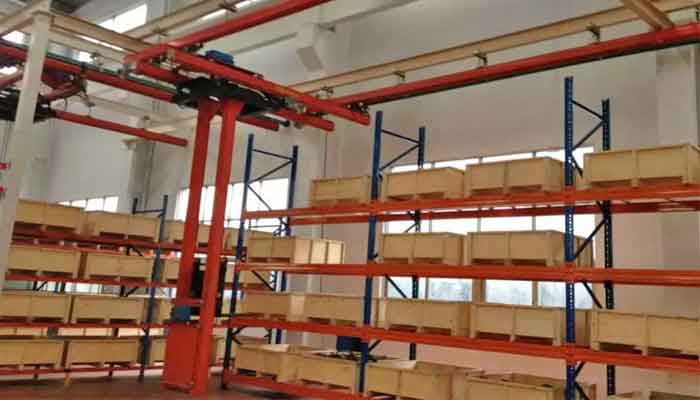
Overview:
Double girder cranes used in warehousing and logistics efficiently handle heavy loads within warehouse facilities.
Typical Double Girder Crane Design & Capacities:
Designed for lifting heavy pallets and goods with capacities ranging similarly from 5 tons to over 100 tons.
Typical Crane Features and Benefits:
Efficient Material Handling: Facilitates organized movement and storage of heavy goods.
Space Optimization: Utilizes vertical space efficiently for multi-level storage.
Reliable Performance: Ensures safe and precise lifting operations within warehouses.
Applicable Industries of Warehousing and Logistics Double Girder Cranes:
Distribution Centers,- Storage Facilities,- Loading Docks,- Material Handling Depots,etc.
In warehousing and logistics settings, these cranes contribute significantly to material handling:
Distribution Centers: Efficiently moving and organizing heavy pallets and goods.
Storage Facilities: Storing and retrieving heavy loads with precision and safety.
Loading Docks: Loading and unloading heavy cargo from trucks or containers.
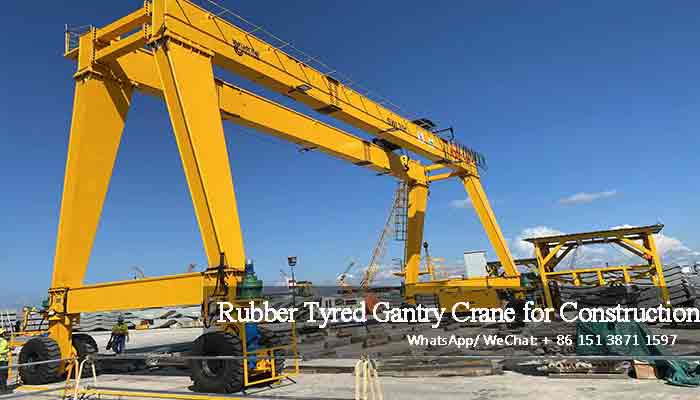
Overview:
Double girder cranes utilized in construction sites play a crucial role in lifting and moving construction materials.
Typical Double Girder Crane Design & Capacities:
Designed to handle construction materials and equipment, ranging from 5 tons to over 100 tons in capacity.
Typical Crane Features and Benefits:
Construction Material Handling: Lifts and positions heavy construction materials effectively.
Enhanced Reach: Capable of lifting materials to various heights and distances.
Versatility in Construction Operations: Assists in various stages of construction projects.
Applicable Industries of Construction Sites Double Girder Cranes:
--Double girder cranes play a pivotal role in various construction applications:
Building Construction: Hoisting heavy building materials to different levels.
Bridge Construction: Lifting steel girders and concrete elements.
Infrastructure Development: Assisting in the installation of large components.

Automotive Industry
Overview:
Double girder cranes in the automotive sector facilitate the handling and assembly of car parts and vehicles.
Typical Double Girder Crane Design & Capacities:
Tailored to handle car bodies, engines, and chassis during assembly with capacities ranging similarly from 5 tons to over 100 tons.
Typical Crane Features and Benefits:
Precision in Assembly: Assists in precise positioning and assembly of vehicle components.
Efficient Material Handling: Lifts and moves heavy automotive parts during production.
Streamlined Manufacturing Operations: Optimizes the assembly process for vehicles.
Applicable Industries of Automotive Industry Double Girder Cranes:
In the automotive sector, these cranes facilitate the assembly and movement of components:
Vehicle Manufacturing: Handling car bodies, engines, and chassis during assembly.
Auto Repair Workshops: Lifting and positioning heavy vehicle parts for repairs.
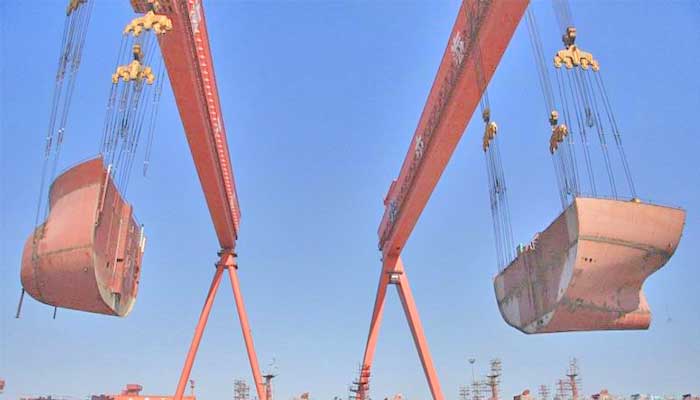
Overview:
Double girder cranes in shipyards and port areas handle heavy components and materials essential for shipbuilding and port operations.
Typical Double Girder Crane Design & Capacities:
Designed for lifting heavy sections of vessels and cargo with capacities ranging similarly from 5 tons to over 100 tons.
Typical Crane Features and Benefits:
Heavy Material Handling: Efficiently lifts and positions ship components and cargo.
Large-Scale Load Management: Capable of handling bulk materials in port areas.
Critical Support in Shipbuilding: Assists in assembling and positioning ship parts.
Applicable Industries of Shipbuilding and Ports Double Girder Cranes:
Double girder cranes are indispensable in shipyards and port facilities:
Shipbuilding: Maneuvering and placing heavy sections of vessels during construction.
Port Operations: Loading and unloading cargo from ships in port areas.
Top Concerns of Users of Double Girder Cranes
Safety Measures and Compliance
Ensuring safety is paramount when operating double girder cranes:
Load Limits: Adhering to the specified load limits to prevent overloading accidents.
Collision Prevention: Implementing safety devices to prevent collisions between cranes or with structures.
Compliance Standards: Adhering to industry safety standards and regulations for crane operations.
Maintenance and Durability
Maintaining the crane's performance and longevity is crucial:
Regular Inspections: Conducting routine inspections to detect and address any mechanical issues promptly.
Scheduled Maintenance: Adhering to maintenance schedules to ensure optimal functionality.
Component Durability: Utilizing high-quality components for enhanced durability and reliability.
Operator Training and Expertise
Skilled operators are essential for safe and efficient crane operations:
Training Programs: Providing comprehensive training programs for crane operators.
Experience and Expertise: Employing experienced operators familiar with the specific crane's operations.
Safety Protocols: Ensuring operators are well-versed in safety protocols and emergency procedures.
Customization and Adaptability
Tailoring cranes to meet specific operational requirements is vital:
Custom Solutions: Offering customization options to suit unique lifting needs.
Adaptability: Ensuring cranes can adapt to different working environments and tasks.
Future Expansion: Designing cranes with provisions for future modifications or upgrades.
Addressing these concerns is pivotal in optimizing the performance, safety, and longevity of double girder cranes in diverse industrial settings.
Related Questions and Answers on Double Girder Cranes
What Load Capacities Are Available for Double Girder Cranes?
Double girder cranes come in various load capacities tailored to different applications:
Light Duty: Ranging from 5 tons to 20 tons, suitable for lighter lifting requirements.
Medium Duty: Between 20 tons to 50 tons, catering to moderate lifting needs.
Heavy Duty: Exceeding 50 tons, designed for heavy lifting in demanding environments.
How Do I Determine the Right Crane Type for My Industry?
Selecting the appropriate crane type depends on various factors:
Application Requirements: Consider the nature and weight of the loads to be lifted.
Span and Height: Determine the required span and lifting height in your workspace.
Environment: Consider the working environment, such as temperature, humidity, and space constraints.
What Safety Features Should I Look for in Double Girder Cranes?
Ensure the crane is equipped with essential safety features:
Overload Protection: Systems to prevent overloading and protect against potential accidents.
Emergency Stop: Instantly halts crane operations in case of emergencies.
Collision Avoidance: Devices that prevent collisions between cranes and structures or other equipment.
How Often Should Maintenance be Conducted?
Regular maintenance is vital for crane performance and longevity:
Scheduled Inspections: Conduct routine inspections as per manufacturer guidelines.
Preventive Maintenance: Perform preventive maintenance tasks regularly to avoid breakdowns.
Usage-based Maintenance: Adjust maintenance schedules based on crane usage and environmental factors.
Conclusion: Partnering for Efficiency and Safety
Choosing the Right Double Girder Crane Supplier
Selecting a reliable supplier is fundamental for a successful crane acquisition:
Experience and Expertise: Look for suppliers with a proven track record and expertise in crane manufacturing.
Quality and Compliance: Ensure the supplier adheres to industry standards and provides high-quality, compliant products.
Customization Options: Choose a supplier offering customizable solutions to match specific operational needs.
Continual Support and Service
A dedicated support system ensures continual assistance throughout the crane's lifecycle:
Installation and Commissioning: Reliable suppliers offer expert installation and commissioning services.
Routine Maintenance: Opt for suppliers providing maintenance contracts for timely service and support.
Emergency Response: Partner with suppliers offering swift emergency support and spare parts availability.
Optimizing Operations with Double Girder Cranes
Maximizing crane efficiency requires strategic planning and operational considerations:
Training and Skill Development: Invest in continuous training for operators to enhance efficiency and safety.
Process Optimization: Utilize cranes effectively by optimizing workflows and operational processes.
Technological Integration: Explore advancements like automation or remote monitoring for improved operations.
In conclusion, the selection of the right supplier, continual support, and strategic optimization of operations are pivotal in maximizing the efficiency and safety of double girder cranes. Partnering with a reliable supplier ensures a seamless experience, from procurement to ongoing maintenance, enhancing productivity and safety standards within industrial environments.
Main Projects
Related Products

Supplied three grab bucket crane kits to Indonesia, enhancing garbage handling efficiency with high load capacity and reliable performance.
Free consultation to Confirm Parameters & Specifications and Get
Latest Crane Price & Crane Rate.
- Types of overhead cranes : _______?
- Optional: Overhead travelling crane, goliath gantry crane,Slewing jib crane, Single girder or double girder crane,small portable crane or kbk crane, etc.
- Capacity of overhead crane: _______?
- Optional: 0.25ton, 0.5 ton, 1 ton, 2 ton, 3ton, 5 ton, 10 ton,15ton, 20ton, 25 ton, 30ton,35ton, up to 550ton, etc.
- Crane span & lifting height : _______?
- Crane travelling length : _____?
- Control of overhead crane:_______?
- Optional: pendant/ remote/cabin control
- Voltage supply of overhead crane:_____?
- Eg,: 380V50/60HZ,3Phase or others,etc.
- Application/usage of crane:_______?
- Eg,: Steel mill, ,injection mold, cement,stone, concrete,granite, general manufacturing, etc.
Just leave a message via the contact form and our hoist and crane engineer will contact you with in 24working hours.
Get In Touch
